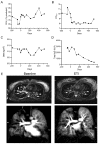Personalized CFTR Modulator Therapy for G85E and N1303K Homozygous Patients with Cystic Fibrosis
- PMID: 37569738
- PMCID: PMC10418744
- DOI: 10.3390/ijms241512365
Personalized CFTR Modulator Therapy for G85E and N1303K Homozygous Patients with Cystic Fibrosis
Abstract
CFTR modulator therapy with elexacaftor/tezacaftor/ivacaftor (ETI) has been approved for people with CF and at least one F508del allele in Europe. In the US, the ETI label has been expanded to 177 rare CFTR mutations responsive in Fischer rat thyroid cells, including G85E, but not N1303K. However, knowledge on the effect of ETI on G85E or N1303K CFTR function remains limited. In vitro effects of ETI were measured in primary human nasal epithelial cultures (pHNECs) of a G85E homozygous patient and an N1303K homozygous patient. Effects of ETI therapy in vivo in these patients were assessed using clinical outcomes, including multiple breath washout and lung MRI, and the CFTR biomarkers sweat chloride concentration (SCC), nasal potential difference (NPD) and intestinal current measurement (ICM), before and after initiation of ETI. ETI increased CFTR-mediated chloride transport in G85E/G85E and N1303K/N1303K pHNECs. In the G85E/G85E and the N1303K/N1303K patient, we observed an improvement in lung function, SCC, and CFTR function in the respiratory and rectal epithelium after initiation of ETI. The approach of combining preclinical in vitro testing with subsequent in vivo verification can facilitate access to CFTR modulator therapy and enhance precision medicine for patients carrying rare CFTR mutations.
Keywords: CFTR; CFTR modulator; G85E; N1303K; cystic fibrosis; human nasal epithelial cells; intestinal current measurement; nasal potential difference.
Conflict of interest statement
S.Y.G. reports grants from Vertex Pharmaceuticals; and lecture honoraria from Chiesi and Vertex Pharmaceuticals; and advisory board participation for Chiesi and Vertex Pharmaceuticals, outside the submitted work. M.AM. reports grants from Vertex Pharmaceuticals; fees for advisory board participation or consulting from Abbvie, Antabio, Arrowhead Pharmaceuticals, Boehringer Ingelheim, Enterprise Therapeutics, Kither Biotech, Pari, Prieris, Recode, Santhera, Splisense, Vertex Pharmaceuticals; lecture honoraria from Vertex Pharmaceuticals; travel support from Boehringer Ingelheim and Vertex Pharmaceuticals outside the submitted work. J.R. received lecture honoraria from Vertex Pharmaceuticals outside the submitted work. M.S. reports grants from Vertex Pharmaceuticals; and lecture honoraria from Vertex Pharmaceuticals; and advisory board participation for Vertex Pharmaceuticals, outside the submitted work. All other authors declare no conflict of interest.
Figures




Similar articles
-
Theratyping cystic fibrosis patients to guide elexacaftor/tezacaftor/ivacaftor out-of-label prescription.Eur Respir J. 2023 Oct 19;62(4):2300110. doi: 10.1183/13993003.00110-2023. Print 2023 Oct. Eur Respir J. 2023. PMID: 37696564
-
Response to Elexacaftor/Tezacaftor/Ivacaftor in people with cystic fibrosis with the N1303K mutation: Case report and review of the literature.Heliyon. 2024 Feb 28;10(5):e26955. doi: 10.1016/j.heliyon.2024.e26955. eCollection 2024 Mar 15. Heliyon. 2024. PMID: 38463894 Free PMC article.
-
The clinical effectiveness of elexacaftor/tezacaftor/ivacaftor (ETI) for people with CF without a F508del variant: A systematic review and meta-analysis.J Cyst Fibros. 2024 Sep;23(5):950-958. doi: 10.1016/j.jcf.2024.07.012. Epub 2024 Jul 23. J Cyst Fibros. 2024. PMID: 39048464
-
Comprehensive Assessment of CFTR Modulators' Therapeutic Efficiency for N1303K Variant.Int J Mol Sci. 2024 Feb 27;25(5):2770. doi: 10.3390/ijms25052770. Int J Mol Sci. 2024. PMID: 38474016 Free PMC article.
-
The preclinical discovery and development of the combination of ivacaftor + tezacaftor used to treat cystic fibrosis.Expert Opin Drug Discov. 2020 Aug;15(8):873-891. doi: 10.1080/17460441.2020.1750592. Epub 2020 Apr 15. Expert Opin Drug Discov. 2020. PMID: 32290721 Review.
Cited by
-
The potentiator ivacaftor is essential for pharmacological restoration of F508del-CFTR function and mucociliary clearance in cystic fibrosis.JCI Insight. 2025 Apr 22;10(10):e187951. doi: 10.1172/jci.insight.187951. eCollection 2025 May 22. JCI Insight. 2025. PMID: 40261705 Free PMC article.
-
Laboratory Tools to Predict CFTR Modulator Therapy Effectiveness and to Monitor Disease Severity in Cystic Fibrosis.J Pers Med. 2024 Jan 13;14(1):93. doi: 10.3390/jpm14010093. J Pers Med. 2024. PMID: 38248793 Free PMC article. Review.
-
Pharmacological rescue of the G85E CFTR variant by preclinical and approved modulators.Front Pharmacol. 2024 Nov 18;15:1494327. doi: 10.3389/fphar.2024.1494327. eCollection 2024. Front Pharmacol. 2024. PMID: 39624835 Free PMC article.
-
Progress of personalized medicine of cystic fibrosis in the times of efficient CFTR modulators.Mol Cell Pediatr. 2025 May 5;12(1):6. doi: 10.1186/s40348-025-00194-0. Mol Cell Pediatr. 2025. PMID: 40320452 Free PMC article. Review.
-
Changing profile of bacterial infection and microbiome in cystic fibrosis: when to use antibiotics in the era of CFTR-modulator therapy.Eur Respir Rev. 2024 Dec 4;33(174):240068. doi: 10.1183/16000617.0068-2024. Print 2024 Oct. Eur Respir Rev. 2024. PMID: 39631927 Free PMC article. Review.
References
-
- Barry P.J., Mall M.A., Alvarez A., Colombo C., de Winter-de Groot K.M., Fajac I., McBennett K.A., McKone E.F., Ramsey B.W., Sutharsan S., et al. Triple Therapy for Cystic Fibrosis Phe508del-Gating and -Residual Function Genotypes. N. Engl. J. Med. 2021;385:815–825. doi: 10.1056/NEJMoa2100665. - DOI - PMC - PubMed
-
- Heijerman H.G.M., McKone E.F., Downey D.G., Van Braeckel E., Rowe S.M., Tullis E., Mall M.A., Welter J.J., Ramsey B.W., McKee C.M., et al. Efficacy and safety of the elexacaftor plus tezacaftor plus ivacaftor combination regimen in people with cystic fibrosis homozygous for the F508del mutation: A double-blind, randomised, phase 3 trial. Lancet. 2019;394:1940–1948. doi: 10.1016/S0140-6736(19)32597-8. - DOI - PMC - PubMed
-
- Mall M.A., Brugha R., Gartner S., Legg J., Moeller A., Mondejar-Lopez P., Prais D., Pressler T., Ratjen F., Reix P., et al. Efficacy and Safety of Elexacaftor/Tezacaftor/Ivacaftor in Children 6 Through 11 Years of Age with Cystic Fibrosis Heterozygous for F508del and a Minimal Function Mutation: A Phase 3b, Randomized, Placebo-controlled Study. Am. J. Respir. Crit. Care Med. 2022;206:1361–1369. doi: 10.1164/rccm.202202-0392OC. - DOI - PMC - PubMed
MeSH terms
Substances
Grants and funding
LinkOut - more resources
Full Text Sources
Medical
Molecular Biology Databases
Research Materials

